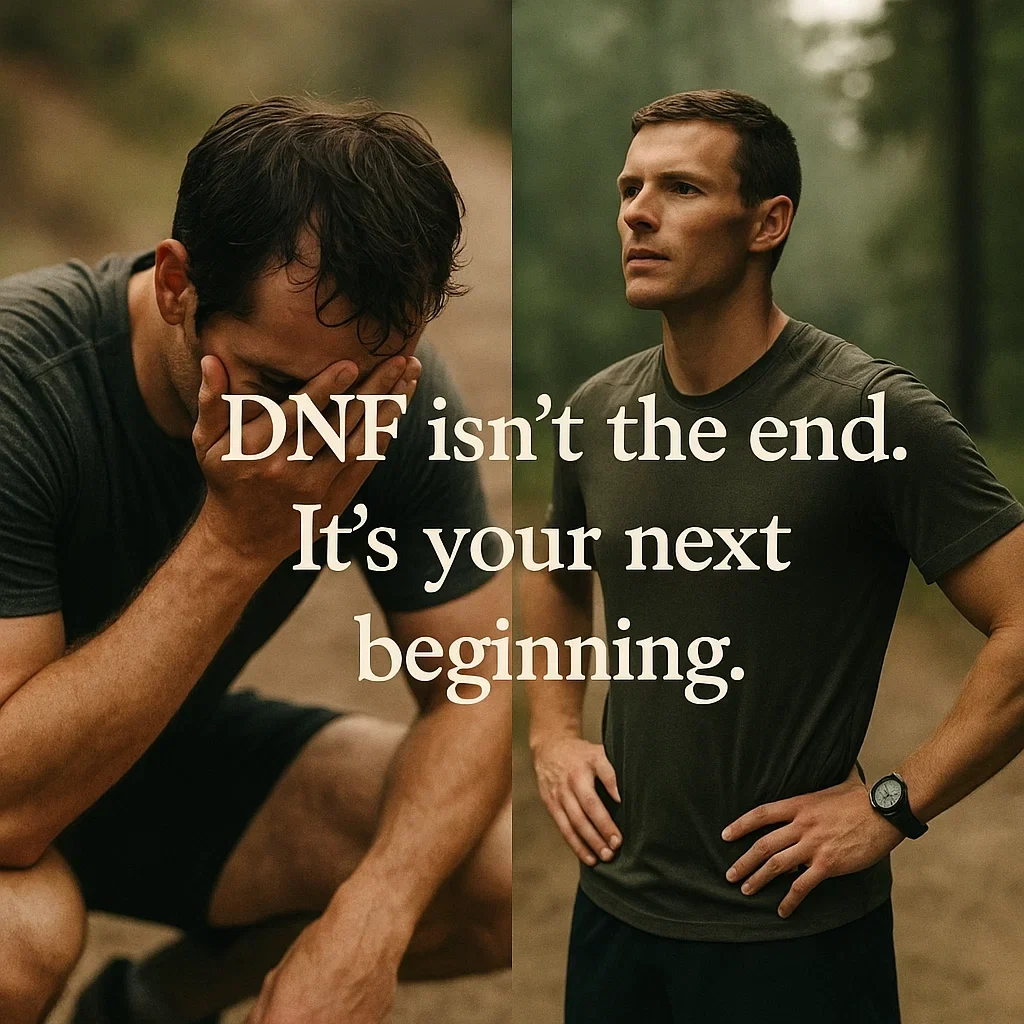🏁 From DNF to Redemption: This Is Not the End of Your Ultra Journey
There’s a moment every ultrarunner dreads — the one where you have to take off your bib before reaching the finish line.
Three simple letters, loaded with emotion: DNF – Did Not Finish.
But let’s get one thing straight:
A DNF does not mean failure.
It means you were brave enough to toe the line. It means you pushed beyond what most people ever attempt. And it means… you now have the opportunity to rise stronger.
Even the world’s toughest ultrarunners have DNF’d.
- Kilian Jornet once dropped from Hardrock due to a torn shoulder.
- Courtney Dauwalter, queen of grit, has had off-days where her body said no.
- Camille Herron, record holder, has openly talked about learning from failed attempts.
You’re in good company.
And this article? It’s your comeback blueprint.
🔧 What You’ll Learn in This Guide:
- 🧠 How to handle the emotional aftermath of a DNF — and not let it define you
- 🔬 How to analyze what went wrong — training, pacing, fueling, mindset
- 🛠️ How to reset and recover — physically and mentally
- 🔁 How to plan your comeback — with targeted, smarter training
- 💥 How to turn a DNF into drive — and finish what you started
You’re not broken.
You’re just unfinished business. Let’s fix that. 👊
💔 Section 1: The Emotional Aftermath – You’re Allowed to Hurt, But Not to Quit
A DNF hurts.
You trained for months. You made sacrifices. You visualized the finish line. And yet… you didn’t cross it.
And that sting? It’s real.
But here’s the first rule of bouncing back from a DNF:
You are allowed to feel disappointed — but you are not allowed to turn that disappointment into identity.
😢 Feel It. Don’t Bury It.
Don’t rush into “being positive.” The disappointment of a DNF deserves to be felt.
Give yourself time to process:
- Cry if you need to.
- Vent to a fellow runner.
- Write a raw race report — even if you never publish it.
What you’re feeling isn’t weakness.
It’s evidence of how much you cared.
💬 Talk It Out – With the Right People
Avoid people who say, “It’s just a race.”
They don’t get it — and that’s okay. But don’t seek comfort from someone who diminishes your effort.
Instead, turn to:
- Running friends who’ve been there
- Coaches or mentors who understand the mental side
- Online forums or communities (Reddit’s r/ultrarunning is full of DNF stories turned to strength)
You’ll find out quickly:
DNF is a shared scar — and the ultrarunning community wears it with pride.
📝 Reframe the Narrative
What if this DNF was the most important race of your career?
Not because you finished — but because it’s the moment you learned the most.
Start by answering:
- What did go right?
- How far did you go?
- What signs did you listen to that maybe prevented real injury?
Write those down. Then write this underneath:
“This wasn’t the end. It was the lesson I needed before my biggest success.”
🔬 Section 2: Analyze the Causes – Why Did You DNF (Really)?
Once the emotional storm settles, it’s time to do the work — not with guilt, but with curiosity.
DNFs don’t happen without a cause.
But blaming yourself blindly helps no one. Instead, think of this as a post-race debrief — a chance to gather intel for your next success.
⚠️ Common DNF Reasons (and What They Might Reveal)
🦴 Injury or Physical Breakdown
- You pushed through early signs (pain, limping, swelling)
- Possible gaps: overtraining, under-recovery, biomechanical issues
🥴 Fueling or Hydration Mistakes
- Bonked hard, stomach shut down, or dehydration hit
- Possible gaps: poor fueling strategy, untested nutrition, GI sensitivity
⏳ Missed a Cutoff
- You simply weren’t fast enough at that point
- Possible gaps: pacing errors early in the race, not enough back-to-back long runs, unfamiliar terrain
💥 Mental Collapse or Panic
- Overwhelm, anxiety, “What am I doing here?” spiral
- Possible gaps: not enough mental training, lack of coping mechanisms, mindset prep skipped
🌪️ External Conditions (Weather, Altitude, Gear Failure)
- Blister storm, cold rain, headlamp died, altitude crushed you
- Possible gaps: underprepared for race environment, gear not field-tested
📝 Do a Post-Mortem (Kindly)
Set aside 20–30 minutes and answer these:
- What went wrong?
- When did it start going wrong?
- Could I have seen it coming?
- Was it avoidable?
- What would I do differently next time?
Be honest, but gentle.
You’re not writing a confession. You’re writing a manual for victory.
🔁 From Breakdown to Blueprint
Take what you learned and turn each point into an action step:
- “I bonked at mile 45” → Test solid foods on long runs
- “I mentally quit at 60” → Add mental training drills weekly
- “I missed the night section” → Practice night runs, upgrade lighting
Every DNF holds a hidden gift:
It shows you exactly where to aim next.
✍️ Download This: Post-DNF Self-Audit Worksheet
Reflect with intention. Use this guided worksheet to unpack your DNF and turn it into a smarter comeback.
🛠️ Section 3: Recovery and Reset – Rest First, Then Rise
You ran for hours. Maybe even over 80 kilometers.
Just because you didn’t finish doesn’t mean you didn’t go far.
Your body still did battle. Your mind still fought. Your heart still showed up.
And now, you need recovery — not punishment.
😴 Physical Recovery Still Matters
Just like after a completed ultramarathon, you’ve earned rest:
- No running for at least 3–7 days
- Gentle movement (walking, yoga, mobility) after 48–72 hours
- Hydrate aggressively, eat nourishing foods (focus on protein + anti-inflammatory nutrients)
- Sleep like it’s your new part-time job 😴
Especially if you DNF’d due to:
- Injury → consult a PT or sports doc before returning
- Stomach issues → rebuild your gut slowly with safe fuel tests
- Fatigue or bonk → check iron, B12, and recovery metrics
🧠 Mental Recovery Is Often the Hardest
You may find it hard to even look at your gear. Or open Strava.
That’s normal. That’s grief — and grief has no deadline.
Here’s what helps:
- Step back from data: Don’t analyze splits unless you’re ready
- Spend time in nature without GPS: Trail walks, barefoot time, no pace required
- Journal your feelings — uncensored
- Rewatch old race footage of yourself: Not to mourn, but to remember who you are
🎯 Set a Gentle “What’s Next?”
Once you feel recovered (mentally and physically), it’s time to set a forward-looking intention.
Not a race date yet. Just something like:
- “I’ll do my favorite trail loop again in 10 days.”
- “I’ll sign up for a 25K next month.”
- “I’ll start base building with easy miles and yoga.”
This is how redemption begins — not in fire, but in a spark.
“This isn’t how my story ends. This is the pause before the comeback.”

🔥 Section 4: The Comeback Plan – Train for What Broke You
Every DNF carries a fingerprint.
A unique moment where something broke — a weakness exposed, a lesson taught.
And that’s where your comeback begins.
Not with doing more, but doing what matters.
🧩 Step 1: Identify The Break Point
Look back at your race notes or memory and mark the moment things went south:
- Mile 37: Legs gave out → No back-to-back long runs?
- Night section panic → No night runs in training?
- GI shutdown → Gels untested at race pace?
- Cutoff missed → Early pacing error + under-fueled?
This is now your training compass. You don’t need revenge.
You need specificity.
🏗️ Step 2: Rebuild Your Base Smarter
Start with consistency, not intensity.
If your DNF came from:
- Endurance cracks → Add back-to-back long runs monthly
- Speed fade → Tempo efforts at the end of long runs
- Mental breakdowns → Practice mantras and visualizations during hard efforts
- Night failure → Run the last hour of your long runs at night
You’re not starting from zero.
You’re starting from wisdom.
🧠 Step 3: Train Your Mind Too
What broke you mentally must now become your weapon:
- Use affirmations during speedwork (“I finish what I start”)
- Run one long run with no music or watch to simulate race solitude
- Do 2–3 runs where you intentionally get uncomfortable:
- hills at the end
- run in rain
- fasted or late-day sessions (to simulate fatigue)
This isn’t punishment. This is programming.
“Tough times don’t last. But a trained mind does.”
🧨 Step 4: Choose a Return Race – But Wisely
Don’t pick the same race out of pride.
Pick it when you’re ready. Pick it when you’ve earned it.
Ask yourself:
- “Do I want revenge or redemption?”
- “Is this race the best place to test my evolution?”
Whether it’s a 50K or another 100-miler, make it a symbol of your new approach.
And when you cross that line?
It won’t erase the DNF.
It will honor it.
🧘♂️ Section 5: Mindset Shift – Turn the DNF Into Drive
DNF.
Three letters that feel like a scar.
But what if —
those same three letters became a badge?
Not of shame.
Of courage.
Because the real power of a DNF is this:
💥 It gives you unfinished business.
And nothing burns hotter than a fire left smoldering.
🧠 Rewire the Narrative
Change your internal story from:
❌ “I failed.”
✅ “I found my weakness. Now I know where to get stronger.”
Every finish line you’ve crossed before?
It made you feel good.
But this DNF — this will make you grow.
🏁 Embrace the Long Game
The most successful ultrarunners in history have multiple DNFs. Why?
Because they take risks. They chase edges. They dare greatly.
And so do you.
So next time you train, carry this mindset:
- “This run isn’t just training my body. It’s forging my redemption.”
- “I don’t need perfection. I need persistence.”
- “Every smart decision I make now builds the finisher I’m becoming.”
💬 Leave the Shame, Keep the Lesson
You don’t owe anyone an explanation.
You don’t owe social media a finish line.
You owe yourself honesty.
You owe yourself a chance to try again — smarter, not just harder.
Because one day, when you finally finish that race…
The medal won’t matter.
What will?
The journey from the day you said:
“I got back up.”

🗣️ Even the Best Fall Short — But Rise Greater

If you think DNFs only happen to beginners or “weaker” runners…
Let’s bust that myth right now.
The greatest ultrarunners in the world — legends you look up to — have failed, cried, and dropped out.
And then? They rose.
🏃♀️ Courtney Dauwalter – The Queen of Pain Cave, DNF’ed Too
In 2017, at the brutal Run Rabbit Run 100, Courtney dropped out late in the race. She pushed too hard, too early — and her body hit a wall.
It wasn’t her first DNF, and it wouldn’t be her last.
But here’s what she said afterward:
“It was humbling. But I don’t regret it — I learned how far I could go before I needed to stop.”
One year later, she returned stronger and crushed her next 100-miler.
The DNF? It became part of her training manual.
🏔️ Kilian Jornet – When Legends Limp Off the Trail
In 2018, Jornet attempted Hardrock 100 again — but dislocated his shoulder during a fall.
Did he try to push through? Nope.
He dropped. With zero ego.
“It was not my day. There will be other mountains.”
And sure enough, next time he returned, he won. Again.
🏅 Camille Herron – Records Built on Resilience
Camille, the 24-hour world record holder, has more DNFs than some people have races.
Nutrition issues, hormonal challenges, pacing errors — she’s seen it all.
“Every DNF taught me something. And I used those to shape my best races.”
Today? She’s a world champion — not in spite of her DNFs, but because of them.
You see, DNF isn’t a black mark.
It’s a badge of honor worn by those who dare to go far enough to fail.
So when you lace up again, remember:
You’re not starting from the bottom.
You’re continuing the path that all champions walk.
📖 From Mile 73 DNF to Finish Line Glory: Alex’s Story
Bu hikaye, okurun “Ben de yapabilirim” demesini sağlayacak. Gerçeklere dayalı kurgusal bir karakterle, birçok ultra koşucunun yaşadığı ortak deneyimi temsil ediyor.
📖 From Mile 73 DNF to Finish Line Glory: Alex’s Story
Meet Alex, a mid-pack ultrarunner.
Not an elite. Not a beginner. Just someone chasing the magic of 100 miles.
🏃 The Dream – And the Drop
In 2022, Alex trained hard for The Grand Mesa 100. Weekly mileage, back-to-backs, nutrition planning — all done.
Race day started strong.
By mile 50, things got harder. By mile 60, things got weird.
At mile 73, on a cold, wind-blasted ridge, Alex sat down.
“My legs weren’t done. But my mind was. I just couldn’t make myself keep going.”
He DNF’ed at the aid station. And cried in the car ride home.
🧠 The Debrief
Three days later, Alex sat down with a notebook and asked:
- Why did I stop?
- What was missing?
The answer?
“I trained my body. But not my mind. I didn’t know how to suffer smart.”
🔄 The Rebuild
Over the next 10 months, Alex trained differently:
- Weekly mindset runs: no music, no GPS, solo time on trail
- Mantra work: “Stay in the mile you’re in”
- Long run simulations: cold weather, darkness, last-10-miles fatigue
- Nutrition tests under stress — not just sipping Tailwind in comfort
🏁 The Return
In 2023, Alex returned to Grand Mesa.
At mile 73, he smiled.
“This time, I knew this place. It didn’t scare me.”
He didn’t just finish. He sprinted the last 400 meters with tears in his eyes.
From DNF to redemption — not because he got stronger, but because he got wiser.
You don’t need to be elite to come back stronger.
You just need to be willing to face your ghosts — and outlast them.
🎥 Watch: What It’s Like to DNF a 100 Mile Ultra Marathon
Coach Char shares her personal experience of not finishing the Faultline Ultra, offering insights into the emotional journey of a DNF.
🎥 Watch: Why I DNF’d My 100 Mile Race
A candid reflection on the factors leading to a DNF in a 100-mile race, offering valuable lessons for fellow ultrarunners.
📚 Further Reading – From Failure to Finish Line
-
🧠 Mental Toughness for Ultramarathons
Train your mind like your muscles – 5 elite strategies to build inner resilience. -
🛁 Post-Ultramarathon Recovery Plan
Still sore after your DNF? This 7-step guide will help you heal, restore, and rebuild. -
🎯 Backyard Ultra Strategy Guide
Master the mental game of “last person standing” races — where DNFs are the rule. -
📘 [NCBI] Psychological Preparation for Endurance Events
Peer-reviewed insights into coping strategies, resilience, and mental fatigue in ultra-endurance athletes. -
📰 A Quieter Way: The Power of Introverts in Ultrarunning
An essay on the place of introverts in ultrarunning, with insights from elite ultrarunners Katie Schide and Jon Albon.
💡 Thanks to the ultra community and scientific contributors who share their wisdom so openly.
🎯 Your DNF Redemption Score
How strong is your comeback mindset?
- 0–19: 😞 “Still healing – give yourself grace and time.”
- 20–27: ⚙️ “Processing – you’re learning and building awareness.”
- 28–35: 🔥 “Recharged – your comeback plan is underway.”
- 36–40: 🦾 “Unfinished Business Fuel – you’re mentally unbreakable.”
💬 Share your score and challenge your running tribe ⬇️

About the Author
Lost Pace is an ultramarathon runner, shoe-tester and the founder of umit.net. Based year-round in Türkiye’s rugged Kaçkar Mountains, he has logged 10,000 + km of technical trail running and completed multiple 50 K–100 K ultras.
Blending mountain grit with data, Lost analyses power (CP 300 W), HRV and nutrition to craft evidence-backed training plans. He has co-written 260 + long-form guides on footwear science, recovery and endurance nutrition, and is a regular beta-tester of AI-driven coaching tools.
When he isn’t chasing PRs or testing midsoles, you’ll find him sharing peer-reviewed research in plain English to help runners train smarter, stay healthier and finish stronger.
Ultrarunner · Data geek · Vegan athlete

